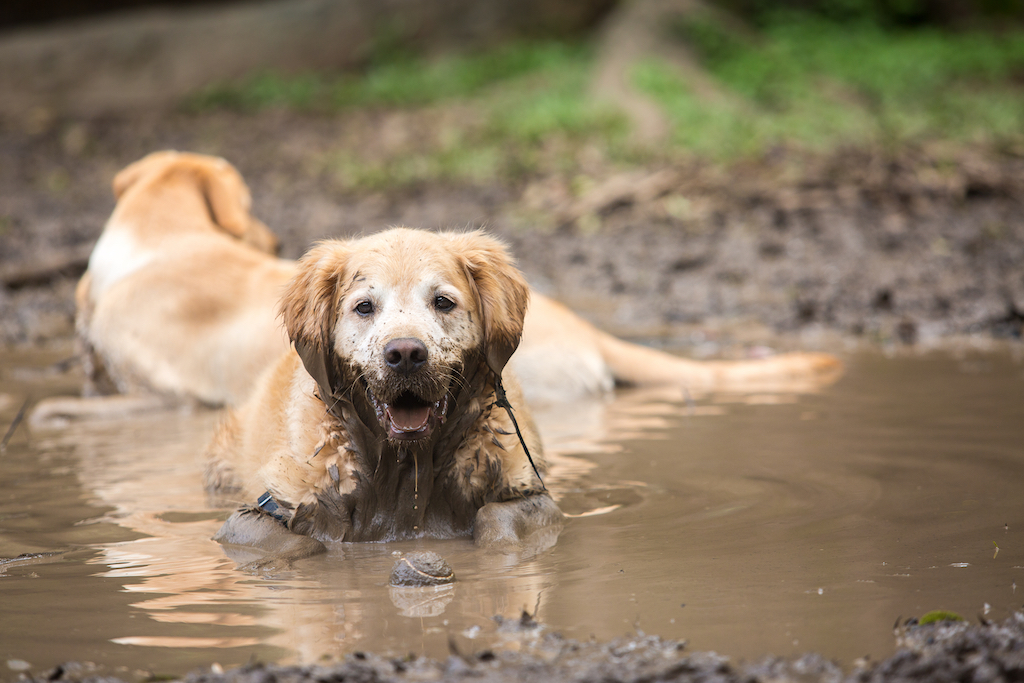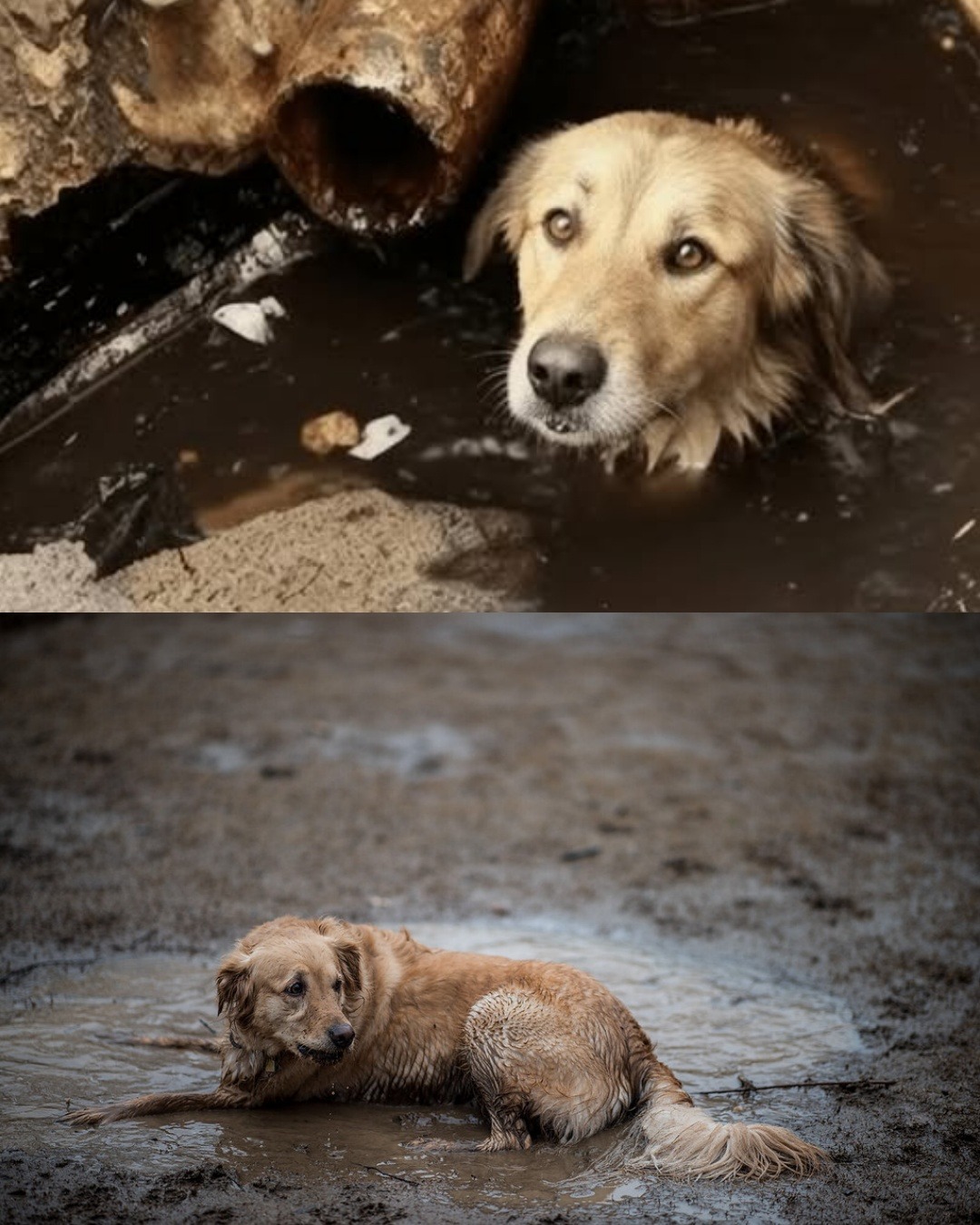The pit of silence
It began in a place where few ever looked — a forgotten corner of rural land, silent except for the wind brushing through dry grass. The ground dipped into a shallow pit filled with rainwater, its surface rippling with the faintest breeze. To anyone passing by, it was nothing more than a muddy hollow. But inside that pit, a small heartbeat struggled to continue.
A dog — frail, trembling, and barely clinging to life — had been trapped there for days. Her fur, once soft and brown, was heavy with mud and cold water. Her eyes, once bright, were dull and glassy. She no longer barked, no longer cried out. Every breath she took was a quiet act of defiance.
No one knew how she ended up there. Maybe she’d been abandoned. Maybe she’d wandered too far. But as the water rose and the hours passed, she fought to stay afloat, pushing her body against the slick walls that offered no grip. She was alone — or so it seemed.

A glance that changed everything
Maria, a volunteer with a local animal rescue, was driving through the backroads when she spotted something strange: a faint movement in the distance. She slowed, squinting through the sunlight. When she stepped out of her truck and approached the pit, her heart dropped. There, barely visible above the waterline, was the dog — shivering, silent, and waiting for help that hadn’t come.
Without hesitation, Maria called for backup. The rescue team arrived with ropes and blankets, working quickly to reach the trapped animal. The pit was steep and slick, making every step dangerous. Maria climbed down slowly, speaking softly to calm the dog.
“It’s okay,” she whispered, extending her hand. “You’re safe now.”
The dog didn’t move at first. She stared with wide, fearful eyes, too weak to even bark. But when Maria knelt and reached closer, something in those eyes flickered — a spark of recognition, maybe even trust.
That was enough.
With gentle care, the team lifted the dog from the cold water, wrapping her in dry blankets. Maria held her close, feeling the fragile body tremble in her arms. For the first time in days — maybe weeks — the dog wasn’t fighting to survive alone.
They named her Hope.

The long road to healing
At the rescue center, Hope’s condition was critical. Her body was malnourished, her fur matted and thin, her skin marked by sores. The veterinarians weren’t sure she’d make it through the night. Still, they did everything they could — warm fluids, antibiotics, gentle feeding.
Maria stayed by her side, whispering to her as machines beeped quietly in the background. “You’re not alone anymore,” she told her. “Just hold on.”
That first night was the hardest. Hope drifted in and out of consciousness, her body fighting exhaustion and fear. But by morning, she was still breathing. Weak, but alive.
In the days that followed, small miracles began to unfold. Hope started to eat on her own — first a few bites, then an entire bowl. Her dull eyes began to regain a faint sparkle. And one morning, when Maria entered her room, Hope lifted her head and wagged her tail. Just once.
It was the smallest movement, but for Maria, it felt like the world had shifted.

Why rescue changes everything — even in science
Stories like Hope’s aren’t just emotional; they reveal something profound about animal psychology. Studies from organizations such as the American Society for the Prevention of Cruelty to Animals (ASPCA) and The Human-Animal Bond Research Institute (HABRI) show that dogs possess complex emotional systems remarkably similar to humans.
They feel grief, joy, fear, and love — and like humans, they can also recover from trauma with time and compassion.
When an animal experiences neglect or isolation, its brain releases high levels of cortisol — the same stress hormone that floods human systems during trauma. But when shown consistent affection and care, cortisol levels drop, and oxytocin — often called the “bonding hormone” — begins to rise. This biological response helps rebuild trust, allowing the animal to form new, positive attachments.
That’s what Maria was unknowingly doing every time she whispered to Hope, every time she stayed through the night. She wasn’t just comforting a frightened dog — she was helping rewire her ability to feel safe again.

Learning to trust again
Recovery wasn’t fast. Hope flinched at sudden noises and shied away from strangers. She often hid in corners, her body low to the ground. But Maria and the rescue team never gave up. They spoke softly, moved slowly, and let Hope decide when she was ready to take the next step.
Weeks passed. Then one morning, Maria entered Hope’s room to find her standing by the door — waiting. Hope trotted forward and nudged Maria’s hand, tail wagging faintly. It was her way of saying, I’m ready.
Day by day, she grew stronger. She began exploring the yard, sniffing flowers and chasing butterflies. She learned to play again, tossing small toys into the air and pouncing after them. The sound of her paws on the grass became a rhythm of joy — a heartbeat rediscovered.
And every time Maria saw her running under the open sky, she felt the same quiet gratitude: the reminder that even broken hearts can heal when given love and time.
Hope’s second chance
Months after her rescue, Hope was ready for adoption. The transformation was astonishing. Her coat gleamed in the sunlight, and her eyes — once lifeless — now sparkled with curiosity.
When a young couple visited the rescue center and met Hope, it was love at first sight. She walked straight up to them, leaned into their touch, and licked their hands. It was as if she knew these were the people who would give her the life she’d always deserved.
Maria watched from a distance, tears in her eyes. It was never easy to say goodbye — but this goodbye was different. This one meant everything had been worth it.
Hope went home with her new family that day. And while she left the rescue center behind, she carried with her every act of kindness that had brought her back to life.
The lasting impact of compassion
Today, Hope runs freely through her family’s backyard, chasing after sticks and curling up on the couch at night. Her scars have faded, but they remain a quiet reminder of what she survived — and what love restored.
For Maria and her rescue team, Hope’s story became a symbol of why they do what they do. “She reminded us that no life is too small, no moment of compassion too late,” Maria said. “Sometimes, hope is all it takes to change a life.”
The psychology of resilience in animals
Scientists often use cases like Hope’s to explore a fascinating phenomenon: learned safety.
Just as humans can recover from trauma through therapy, animals can relearn that the world isn’t always dangerous. When consistent care replaces fear, the brain’s threat systems begin to quiet down.
Hope’s slow tail wag, her decision to eat again, her first steps outside — each was a measurable sign of neural healing. In that sense, rescue isn’t just emotional; it’s biological.
Every gentle word, every kind touch, every bowl of food given with love becomes part of an invisible therapy — one that rewires survival into trust, and fear into affection.

Why these stories matter
Stories like Hope’s go viral for a reason. They remind us of something we often forget in our fast-moving world: compassion still matters.
A simple act — stopping the car, making a phone call, wrapping a cold animal in a blanket — can ripple outward in ways science alone can’t measure.
Across the world, rescue organizations continue to fight against neglect, abuse, and abandonment. Each one carries stories like Hope’s — some heartbreaking, some triumphant — all proving that empathy is one of humanity’s most powerful instincts.
As researchers note, empathy doesn’t just heal the rescued — it heals the rescuer too. Acts of kindness trigger the release of dopamine and serotonin in the human brain, creating feelings of fulfillment and calm. When Maria held Hope in her arms for the first time, that connection wasn’t one-sided. It was mutual healing — one life saving another.
From darkness to light
Hope’s name wasn’t chosen by chance. It was a promise — a word that carried both pain and possibility. From the moment Maria pulled her out of that cold, water-filled pit, Hope’s story became more than a rescue. It became a reflection of something deeply human: our belief that no one — not even a trembling, forgotten dog — is ever truly beyond saving.
And somewhere, in the soft sunlight of a quiet backyard, a dog named Hope now lies peacefully in the grass. Her eyes follow butterflies. Her heart beats strong. And if you listen closely, you might just hear it — the gentle rhythm of a second chance.
Sources
-
American Society for the Prevention of Cruelty to Animals (ASPCA) – “Animal Behavior and Recovery”
-
Human-Animal Bond Research Institute (HABRI) – “The Science of Emotional Healing in Rescue Animals”
-
The Dodo & Feji.io features on animal recovery and compassion
